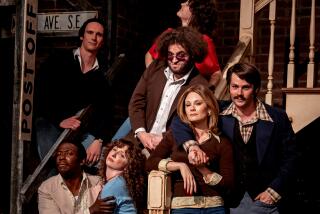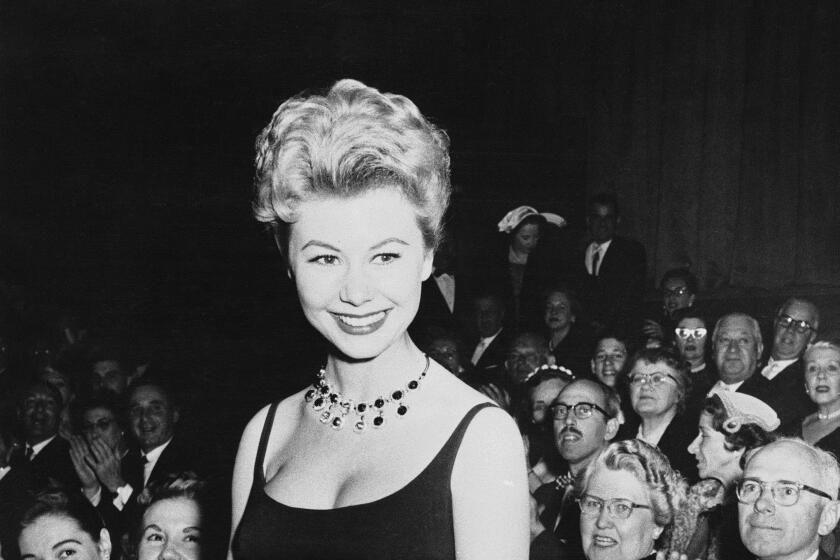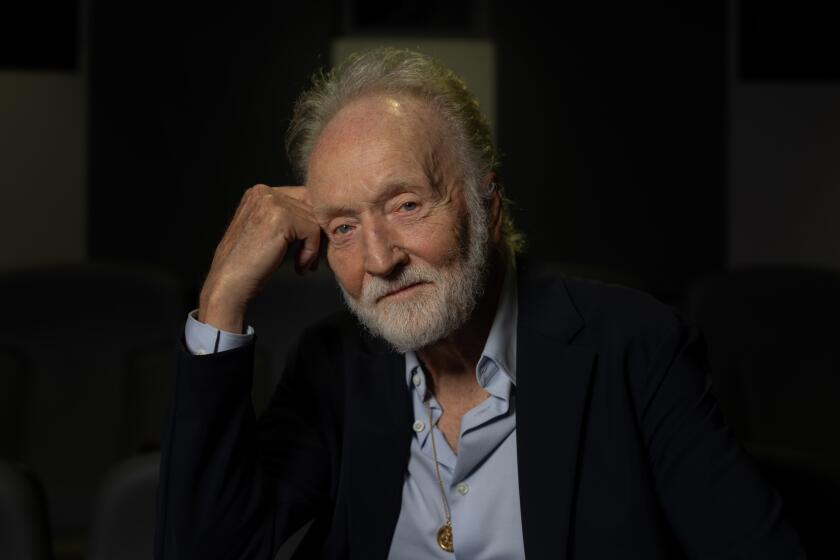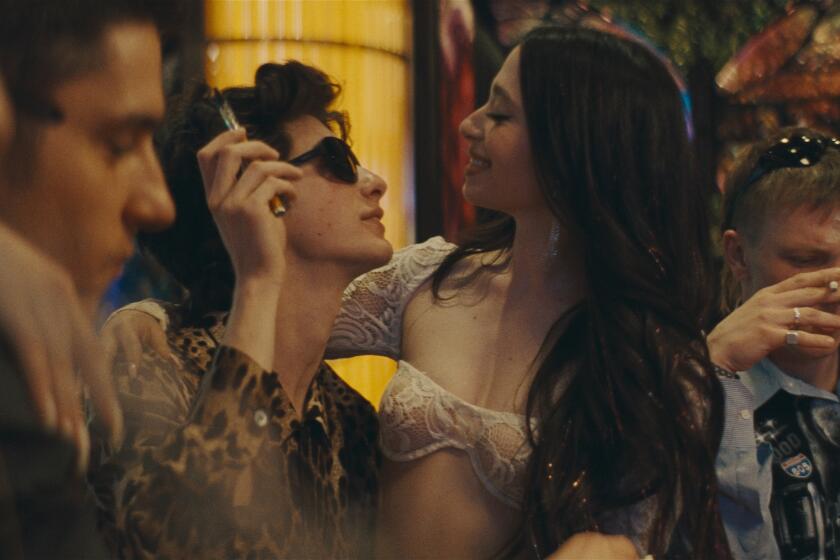The Last Maverick: Inside George Lucas’ Empire
The short, wiry beard is beginning to be flecked with gray. But George Lucas, in a sweater and jeans, continues to look very much like the same reserved and intense young man he was as a USC student 20 years ago, when he was already marked as a film maker to keep an eye on.
Lucas, who is now 44, had caught the industry’s attention with a dazzlingly imaginative student film called “THX-1138-XEB,” about one man’s escape from a city in a grim totalitarian future. Lucas used tunnels and a deserted parking structure to convey a captive world as hard and soulless as concrete itself. He was on his way.
The American film industry may have been built by the moguls, yet it can be argued that it was made by the mavericks--from D.W. Griffith himself by way of Charlie Chaplin, David O. Selznick, John Ford and Orson Welles and continuing through Francis Coppola, Steven Spielberg and Lucas.
They and a relative handful of other creators have been of the industry and yet not wholly in it. Their marks are indelible and they’ve been able to follow their own lights and go their own ways (sometimes, like Welles, with great difficulty) simply because their talent was undeniable and in many cases their ability to make money was irresistible.
George Lucas has had a hand--as writer, producer, director or all three--in five of the eight largest-grossing films of all time. The list began with his “Star Wars” trilogy in 1976 and extends to “Raiders of the Lost Ark” and “Indiana Jones and the Temple of Doom,” whose stories Lucas wrote for his friend Steven Spielberg.
Yet Lucas has been more out of Hollywood than in it. For 20 years he has been living an increasingly secluded if not reclusive life here in Marin County. Here he owns 4,700 acres of lovely and largely vacant rural scenery and here in Marin he has built an impressive state-of-the-art film enterprise, Lucasfilm, Ltd. (incorporated in 1971), that now includes what is claimed to be the largest post-production facility in the world.
The best-known and biggest of Lucasfilm’s five divisions, the aggregation of special-effects wizards called Industrial Light and Magic, just won its eighth Academy Award for its work on “Innerspace.”
This week the newest film from Lucasfilm, “Willow,” a fantasy set in a mythical land of trolls and dragons in some prehistoric time, opens in 1,000 theaters. It is based on an original story by Lucas, who was also the film’s executive producer. It is being released by MGM/UA and was directed by Ron Howard, who at 18 was one of the star’s of Lucas’ first commercial hit, “American Graffiti,” in 1973. (“Graffiti” was shot in San Rafael, beginning Lucas’ close association with the area.)
Howard and Lucas remained close friends and Howard has since become a successful director, with “Splash!” and “Cocoon” among his credits.
Lucas himself has not directed a film since “Star Wars” and he is not certain whether he will ever direct again. He prefers to shape the growth of Lucasfilm and to write and produce. He has actually never enjoyed directing; it may well conflict with his essentially private nature. Even when he was making “Star Wars” he confessed during a luncheon conversation at Pinewood Studios that he would by choice be a captain rather than a general. These days, Lucas admits, “I seem to have become a chief of staff.”
In August another Lucasfilm production opens. It is “Tucker,” directed by his longtime friend Francis Coppola. The film is the story of Preston Tucker, the maverick and visionary automobile designer and manufacturer who tried to buck Detroit and lost, even though his sleek Tucker car had several innovations, like independent suspension and seat belts, that are now standard. It is a story thematically dear to the hearts of both Lucas and Coppola, who have bucked the Hollywood system, with mixed results.
Fortunes of Lucasfilm
Lucas, born in Modesto in Northern California, never cared much for Hollywood and what he saw as its deal-making and double-dealing, its hypocrisies and deceptions and its gift for compromises that leave excellence unachieved and seldom even aspired to.
The business “Willow” does will be watched with keen interest in Hollywood, which tends to wish mavericks well, but not too well. The film’s elaborate special effects, its long schedule and its international locations (England, Wales and New Zealand) have made it expensive. Printed estimates have put the cost at $35 million or $40 million, figures neither Lucasfilm nor the distributor will confirm. Lucas says only that the film is already paid for, thanks to advances from theaters, foreign territorial sales, licensing arrangements and a videocassette deal that Lucasfilm believes is one of the largest yet made.
Because Lucasfilm is privately held and because Lucas dislikes interviews (and is generally uncomfortable being a public figure) speculation arises as to how Lucasfilm is doing and to what extent its fortunes depend on the big money rolling in from its own productions.
The interest is particularly keen because the last feature on which Lucas was executive producer, although he neither wrote nor directed it, was a Universal picture, “Howard the Duck,” which as cynics were quick to note laid a very large egg, critically and commercially. Lucas’ crisp answer is that Lucasfilm is doing fine and doesn’t depend on the earnings of its films.
Life of a Mini-Mogul
His office is in the headquarters building of Lucasfilm, on his Skywalker Ranch some 15 miles from San Rafael in the bucolic and largely untouched Lucas Valley (which despite the coincidence was named not for George but for an early settler).
On a breezy May morning recently, Lucas talked with an old acquaintance about his new life as at least a mini-mogul. “I’m the son of a small-town businessman,” Lucas said. “He was conservative and I’m very conservative and I always have been.
“The guiding principal is that the company can sustain itself without having to make movies. I don’t want to have to make movies. The company is designed so I don’t have to make commercially profitable movies. Your bottom-line assumption has to be that every movie loses money. They don’t, of course, but you go on that assumption. It’s like baseball. You don’t always get into the World Series, but you go on playing.
“I don’t believe in debt, although from time to time you go into debt. But I never go beyond what I can afford to lose. I came from the ranks of independent film-makers, where you had to worry about whether or how you could pay a secretary. I wanted to get to a point where I didn’t have to make a deal so I could pay a secretary.
“I don’t intend to leverage myself into oblivion. And I don’t have to return 10% on capital. But we have a nice profit-sharing plan and a lot of people who are interested in making a nice profit.”
His Biggest Project
“Star Wars” and the other record-grossing films have made Lucas a multimillionaire. Five years ago, according to Dale Pollock’s biography, “Skywalker” (unauthorized, although Lucas cooperated with Pollock), Lucas estimated his personal net worth at $25 million. That did not include the millions ($35 million at that point) that he had placed in Lucasfilm.
What Lucas’ total investment in Lucasfilm amounts to now has not been revealed, although an aggressive Marin newspaper, the Pacific Sun, has put the figure at $80 million and it is hard to see how it can be significantly less.
The headquarters building is in the guise of a very large white frame Victorian mansion, complete with a spacious front porch and gingerbread trim. It looks as if it could have been in place for a century but it is scarcely 2 years old, having been 6 years in the making.
Skywalker Ranch covers 2,600 acres, of which only 5% has been or will be developed. The rest is permanently dedicated as open space. R. Douglas Norby, president and chief operating officer of Lucasfilm, notes that the open space is in better shape than it was pre-Lucas. “The land had been over-grazed and it was eroding badly.” Lucas has planted more than 2,000 trees to check the erosion. Norby, who had previously been chief financial officer for a microchip firm in Silicon Valley, has been on the Lucas board for 8 years and became president 3 years ago.
All the buildings on the ranch sit in a fold in the land and are invisible from Lucas Valley Road, which fronts the property. Invisible as well is the artificial lake Lucas built for fire protection and that has now begun to attract waterfowl, including egrets. In the summer, Lucas has sand trucked in to make a beach and throws a party for his employees and their families. The property includes stables and a softball diamond.
The entrance to Skywalker is an unsigned and easy-to-miss gate. Even the guard post (security is tight) is just around a bend, tactfully out of view from the road.
“It’s my biggest movie,” Lucas says of the ranch, grinning. “I’ve always been a frustrated architect.” The basic shape of the buildings is his. “Then,” he says, “we put together our own design firm and our own construction firm to build them. It was the only way to keep the authenticity.”
The main building in no way resembles the head office of a multimillion-dollar corporation, although it is a triumph of no-expense-spared craftsmanship. Its paneled walls, moldings, sills, steps and banisters are perfectly joined, with seams so fine as to be invisible. The solarium has a stained glass dome, done by a local artisan, that must be a dozen feet in diameter and suggests a Tiffany shade gone mad. The wall art includes originals by Norman Rockwell and Maxfield Parrish.
The headquarters house is one of a set of four buildings (all linked by a vast underground garage) for which story-teller Lucas has invented a kind of family history. Tom Kobayashi, the veteran Hollywood sound engineer who now runs Lucasfilm’s post-production facility, says, “George’s plot is that a retired sea captain built the main house and then added the outbuildings.”
The outbuildings include the Stable, where production, publicity and part of Lucasfilm’s games division are located; the Carriage House, which holds theater operations and licensing, the Gate House, where animation, business affairs and finance are housed, and the Brook House (so named because a brook runs beside it) where more of the games division is located. All of the complex except Brook House are linked by a huge underground garage and all of the outbuildings are faced in brown shingles. They look very New England.
Down the road a few yards is the Tech Building, made of brick and resembling a large winery whose ivy has not had time to climb the walls. A small vineyard, its infant plantings still protected by milk cartons, has just been established in front of the building. “Who knows,” one staff member said, “one day we may have Skywalker Chardonnay.”
Within the Tech Building the architecture suddenly changes from the wooden beams and iron braces of a late 19th-Century winery to Art Deco. “The Captain’s children added on later,” Kobayashi explains, standing in a corridor where the centuries meet.
The building contains about 150,000 feet of space, with a gorgeous recording stage that can accommodate a 100-piece orchestra and that the Grateful Dead have rented for two weeks in June. A dialogue-dubbing stage has windows that look on the handsome hills outside, a Lucas courtesy to actors who usually have only bare walls to look at. There are long corridors on two floors lined with editing rooms.
All the buildings somehow carry aromas of toast and chocolate chip cookies. “There are kitchens everywhere ,” says Lynne Hale, who is head of publicity for Lucasfilm, having previously worked for Coppola on “Gardens of Stone.”
Taxing Problems
Originally Lucas had intended to locate Industrial Light and Magic on Skywalker as well. Along with Sprocket Systems, which developed Lucas’ THX sound, ILM was the earliest of the Lucas enterprises in Marin. But ILM had grown so big so quickly that it had more employees (as many as 250, depending on the workload) than the tough zoning restrictions on Skywalker would permit to work on the ranch.
ILM now spills through more than a half-dozen converted warehouses, crowded and disjointed, in the city of San Rafael, 15 inefficient miles from the rest of the Lucasfilm operation.
Lucas hopes to locate ILM on a property called the Grady Ranch adjoining Skywalker to the east and totaling 1,050 acres, of which only 50 would be developed, the rest remaining as open space. Like the Skywalker constructions, the ILM building, with a footprint (as the architects now like to say) of 250,000 square feet, would be hidden in another fold of the land and be invisible from the highway. Like the parking, the first floor would actually be below ground level.
Lucasfilm has not yet filed a formal request with the county to do the building. Lucas and his team are working on the plans and it will be another two months before the request is actually filed. But when Norby and others began outlining their intentions at local meetings, with an eye to gaining public support, some lively political opposition developed (See separate article on Page 6).
Another political hassle has arisen over how much real estate tax Lucasfilm should pay on its Marin properties. As Norby explains it, officials recognize three allowable bases for determining the tax: the actual historical cost, comparable recent sales and the income the property is generating. Marin County thinks Lucasfilm owes about four times as much as Lucasfilm believes it owes.
“We and Fireman’s Fund insurance are the two largest employers in the county, and we’re seen as the deep pockets, for everything,” says Norby. He is sure a compromise can be reached on the taxes.
A Balancing Act
Meanwhile George Lucas is balancing his roles as chief executive of a company that is trying to anticipate the technology of the film industry in the 1990s, and as a creator who is making films now.
This week production begins in London on what is temporarily being called “Indie III,” the third Indiana Jones film, with Harrison Ford starring again in a Lucas story and Spielberg directing. Lucas and Spielberg are also co-executive producing “Land Beyond Time,” an animated film featuring baby dinosaurs and being directed by Don Bluth (“The Secret of NIMH”).
The Lucas Theme
“Willow,” Lucas says, is an idea that grew out of the research into myths that he did for “Star Wars” 15 years ago. The unique feature of “Willow” is the casting of little people in the principal roles. “I thought of doing ‘Star Wars’ with little people,” he says, “but at that time I didn’t know how to cast it.”
He met Warwick Davis, who plays the 3-foot-4-inch title character Willow, when Davis was an extra on “Return of the Jedi” in London. Davis, who is from Surrey, was then only 13. “I liked his face so much I replaced the man who’d been cast and gave him the part of Wicket, the smallest Ewok. After I met him, I knew I’d be able to do ‘Willow’ one of these days.”
In Lucas’ mind there is a kind of bridge of innocence linking “American Graffiti,” “Star Wars” and “Willow.” “American Graffiti” was innocent, earnest and positive if not mythic. “Willow,” like the “Star Wars” trilogy, is earnest and innocent and also involves a mythic struggle of good versus evil, with good winning even though it appears hopelessly overmatched. And, too, as Lucas puts it, “Mr. Average Man rises to the occasion”--a favorite Lucas theme.
He has notes and ideas for many more films large and small, Lucas says, including extensions of “Star Wars,” which he had originally envisioned as not one but four trilogies.
“I’m not sure I can get to them all in my lifetime,” Lucas says. “By the time of ‘Star Wars’ the productions had gotten so big that I couldn’t do everything myself. I had a choice. I could go back to making tiny films where I could do everything myself, or I could develop a creative apparatus for working with other people.” That’s what he’s done.
These days, he says, “I’m able to make contributions in the story and in finishing the picture. That’s where I’m best and that’s what I enjoy the most. It’s like being able to cook dinner without having to do the dishes. But there are others who love to do the dishes so it works out fine.”
Changing Priorities
It is clear that Lucas has reordered his priorities in recent years. He is divorced, painfully and expensively, from his wife Marcia, and has been keeping company with Linda Ronstadt. She recently bought a home in San Francisco but after columnist Herb Caen printed the address she has had hordes of gawkers and one break-in and thinks she may have to start again.
For a time Lucas all but abandoned film-making to concentrate on creating Skywalker Ranch and, in his words, putting Lucasfilm right. “One day there were a dozen of us and the next time you looked there were several hundred.”
Some operations were sold off or shut down. “We were duplicating systems the studios had in place already. We stopped that,” Lucas says. (Doug Norby has added that Lucasfilm no longer intends to manufacture technology but only to design and then license it.)
Today there are perhaps 150 staffers at Skywalker, between 50 and 250 at ILM, depending on the number of assignments.
‘Success Is Insidious’
“Life is better than when I was giving 110% of myself,” says Lucas. “When I was finishing ‘Jedi,’ I was consumed by that movie. I realized I wanted to do other things than make movies.
“Success is insidious. You think you can manage it but it creeps up on you. It tests you and everyone around you. I thought maybe because I’d got it in increments I could handle it. But . . . it’s hard.”
Then George Lucas says the heretical: “There’s more to life than making movies.”
More to Read
Only good movies
Get the Indie Focus newsletter, Mark Olsen's weekly guide to the world of cinema.
You may occasionally receive promotional content from the Los Angeles Times.










